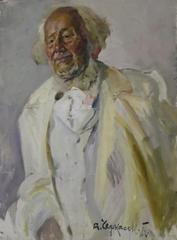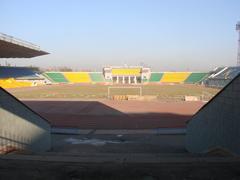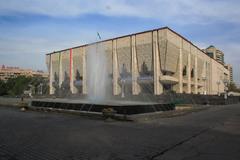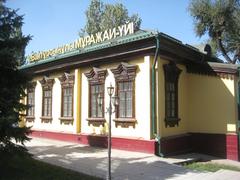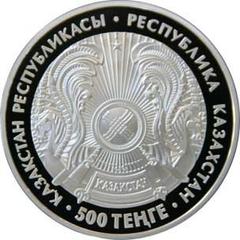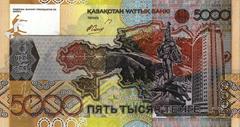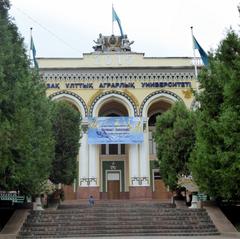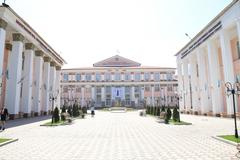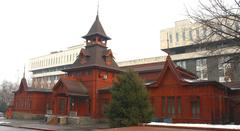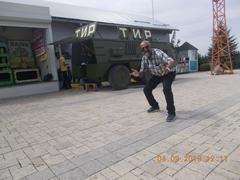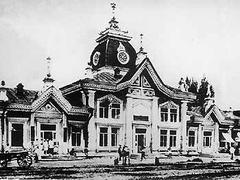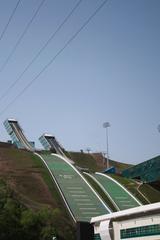Wedding Palace in Almaty: Visiting Hours, Tickets, and Historical Significance
Date: 04/07/2025
Introduction
Nestled in the heart of Almaty, Kazakhstan, the Wedding Palace (Neke saraiy, Неке сарайы) is a unique fusion of Soviet-era modernist architecture and enduring Kazakh cultural traditions. As the city’s primary civil marriage registration office and a celebrated symbol of unity, the palace stands as both a functional civic space and a living monument to the evolution of Kazakh society. Its design, inspired by the motif of interlocking wedding rings, and its role as a hub for vibrant social and cultural activity make it a must-visit destination for locals and tourists alike. This guide provides a comprehensive overview of the Wedding Palace’s history, architectural highlights, cultural significance, visiting hours, ticketing, accessibility, and nearby attractions (Wikipedia: Almaty; Folklore.ee: Kazakh Wedding Ceremony; Advantour; EAA: Architectural Buildings in Almaty; Explore Travel Oasis).
Table of Contents
- Historical Evolution
- Architectural and Cultural Symbolism
- Visitor Information
- Cultural Significance and Traditions
- Nearby Attractions
- Practical Tips for Visitors
- Frequently Asked Questions (FAQ)
- Conclusion
- References
Historical Evolution
Soviet Urban Planning and the Rise of the Wedding Palace
Constructed in the early 1970s under the guidance of architects Mendikulov Malbagar and Alexander Leppik, the Wedding Palace in Almaty is a quintessential product of Soviet urban planning. During this era, the Soviet Union aimed to secularize and standardize significant life events, including marriage, by establishing official venues for civil ceremonies. The construction of “Wedding Palaces” across the USSR reflected this vision, providing a unified space for registering marriages while embedding socialist values into daily life (Wikipedia: Almaty).
The Almaty Wedding Palace was designed as both a functional registration office and an architectural statement. Its central city location, grand facades, and symbolic motifs underscored its civic importance and accessibility to all citizens.
Social Context: Marriage Traditions and Modernization
Pre-Soviet and Soviet Era
Before Soviet rule, Kazakh marriages were rooted in clan-based, Islamic, and nomadic traditions. Elaborate multi-day celebrations included rituals such as kyz uzatu (bride’s farewell) and betashar (unveiling of the bride), serving as both personal and communal milestones (Folklore.ee: Kazakh Wedding Ceremony). The Soviet state later promoted civil registration as the sole legal form of marriage, relegating religious ceremonies to private life. The Wedding Palace became the standardized setting for these new secular rites.
The Wedding Palace as a Social Hub
Beyond its administrative role, the Wedding Palace quickly emerged as a social center where families and communities gathered for one of life’s most significant events. The building’s spacious halls, waiting lounges, and ceremonial rooms facilitated both efficient registration and festive celebration.
Post-Soviet Developments and Contemporary Significance
Following Kazakhstan’s independence in 1991, there was a cultural revival that saw many couples incorporating traditional Kazakh rituals into their Wedding Palace ceremonies. Today, the palace accommodates diverse customs and is equipped to serve international and multiethnic couples. Its ongoing adaptations ensure it remains a vital institution in Almaty’s civic and cultural landscape (EAA: Architectural Buildings in Almaty).
Architectural and Cultural Symbolism
The Wedding Palace’s two interlocking cylindrical volumes, symbolizing wedding rings, are a striking representation of unity and continuity. The white marble facade, geometric sun-protection grids inspired by Kazakh knot motifs, and Soviet-era mosaics depicting folkloric scenes create a harmonious blend of modernist and traditional aesthetics. The interior, reminiscent of a Kazakh yurt, features a domed ceremonial hall, ornate chandeliers, and national ornaments that reinforce the atmosphere of solemnity and celebration.
Renovations in 2001 and 2013 updated the palace while preserving its most significant architectural and artistic features. Recent restoration efforts are dedicated to maintaining the building’s historic exterior and decorative elements.
Visitor Information
Visiting Hours and Tickets
- Hours: The Wedding Palace is typically open Monday through Saturday, 9:00 AM – 6:00 PM. It is closed on Sundays and public holidays.
- Admission: Entrance to the exterior and public areas is free. Guided tours of the interior may require advance booking and a nominal fee.
- Booking: For guided tours or to attend public exhibitions, booking in advance via the official city tourism website or local tour operators is recommended.
Accessibility
The Wedding Palace is fully wheelchair accessible, with ramps, elevators, and accessible restrooms. Staff are available to assist visitors with mobility needs.
Guided Tours and Special Events
Guided tours are occasionally offered and provide valuable insights into the building’s history, architecture, and the evolution of Kazakh wedding traditions. The palace also hosts cultural exhibitions and traditional wedding reenactments. Check local tourism resources for current offerings.
Photography Policy
Photography is permitted in public areas and the exterior. Interior photography may be restricted during private ceremonies or special events—always seek staff approval before photographing inside the ceremonial halls.
How to Get There
Located on Abay Avenue near the Vesnovka river, the Wedding Palace is easily reachable by public bus, metro, or taxi. Parking is available but limited; public transport or ride-hailing services are advisable.
Cultural Significance and Traditions
The Role of Weddings in Kazakh Culture
Weddings are central to Kazakh life, symbolizing unity, continuity, and respect for heritage. The Wedding Palace serves as a modern venue where ancient customs and contemporary practices blend seamlessly (Advantour).
Traditional Customs
- Matchmaking (Quda Tusu) and Engagement (Syrga Salu): Formal agreements between families and symbolic gift exchanges mark the beginning of the marriage journey (Nomads Life).
- Pre-Wedding Rituals (Kiz Uzatu): Emotional farewell ceremonies for the bride, rich with music and blessings (Tourstokazakhstan).
- Wedding Day (Toy): Blends religious rites (Neke Kiyar) and traditional celebrations (Betashar), accompanied by folk music and communal feasting (Advantour).
- Post-Wedding Visits: Reciprocal exchanges of gifts reinforce family bonds.
The palace’s architecture and mosaics incorporate these traditions, making it a meaningful site for both ceremonies and cultural exploration.
Multicultural Influences
Almaty’s diverse population is reflected in wedding celebrations that blend Kazakh, Russian, Uighur, and other customs, fostering a unique, multicultural atmosphere (MexicoHistorico).
Nearby Attractions
Enhance your visit by exploring adjacent landmarks:
- Panfilov Park & Zenkov Cathedral: Lush park and a renowned wooden cathedral, ideal for leisurely walks (One in the Orange Jacket).
- Green Bazaar: Bustling market with local delicacies and crafts (One in the Orange Jacket).
- Arasan Baths: Historic bathhouse for relaxation (Postcards from the World).
- Almaty Central Mosque: Architectural gem combining Kazakh and Islamic motifs.
- Kok-Tobe Hill: Offers panoramic city views accessible by cable car (Travelspilot).
- Hotel Kazakhstan Rooftop Bar: Stunning Tien Shan mountain vistas (Explore Travel Oasis).
- Almaty Metro: Notable for its artistic station designs.
Practical Tips for Visitors
- Dress Code: Dress modestly, especially inside ceremonial areas.
- Photography: Always request permission before photographing people or inside ceremony halls.
- Language: Staff speak Kazakh and Russian; a translation app or local guide is helpful.
- Timing: Weekday mornings are quieter; weekends are busier with ceremonies.
- Transport: Use public transport or taxis for convenience.
- Amenities: Waiting lounges, restrooms, and occasional cafes or souvenir kiosks are available.
Frequently Asked Questions (FAQ)
Q: What are the Wedding Palace visiting hours?
A: Monday–Saturday, 9:00 AM–6:00 PM. Closed Sundays and public holidays.
Q: Do I need tickets to visit?
A: Entry to public areas is free. Guided tours may require advance booking and a small fee.
Q: Is the palace accessible for visitors with disabilities?
A: Yes, the building is wheelchair-friendly and equipped with elevators.
Q: Is photography allowed?
A: Allowed in public areas; restricted during private ceremonies. Always ask staff.
Q: Are guided tours available?
A: Occasionally, and they must be booked in advance through local tourism operators.
Conclusion
The Wedding Palace in Almaty stands as a testament to Kazakhstan’s architectural innovation and vibrant cultural heritage. Whether you’re drawn by its striking modernist design, intrigued by the blend of traditional and contemporary wedding customs, or simply seeking a unique cultural experience, the palace offers a welcoming and insightful visit. Explore the palace, immerse yourself in local traditions, and take the opportunity to discover Almaty’s broader cultural landscape.
For the latest updates on visiting hours, tours, and events, consult official resources or download the Audiala app for personalized travel guidance. Make the Wedding Palace a highlight of your journey through the heart of Kazakhstan.
References
- Wikipedia: Almaty
- Kazakh Wedding Ceremony (Folklore.ee)
- Wedding Traditions in Kazakhstan (Advantour)
- Architectural Buildings in Almaty (EAA)
- Things to Do in Almaty (Explore Travel Oasis)
- Kazakh Wedding Traditions (Nomads Life)
- Cultural Richness of Almaty (MexicoHistorico)
- Traditions of Kazakhstan Weddings (OrexCA)
- Things to Know Before Visiting Almaty (One in the Orange Jacket)
- 6 Days in Almaty (Postcards from the World)
- Things to Do in Almaty (Travelspilot)
